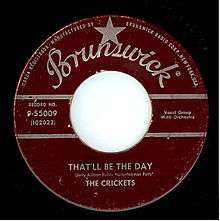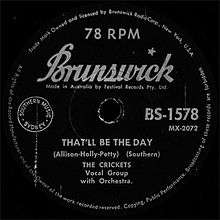That'll Be the Day
| "That'll Be the Day" | ||||||||||
|---|---|---|---|---|---|---|---|---|---|---|
 1957 U.S 45-rpm (Brunswick 9-55009) | ||||||||||
| Single by the Crickets | ||||||||||
| from the album The "Chirping" Crickets | ||||||||||
| B-side | "I'm Looking for Someone to Love" | |||||||||
| Released | May 1957[1] | |||||||||
| Format | 7" 45-rpm, 10" 78-rpm | |||||||||
| Recorded | February 25, 1957, Norman Petty Recording Studio, Clovis, New Mexico | |||||||||
| Genre | ||||||||||
| Length | 2:16 | |||||||||
| Label | Brunswick U.S. single 55009; Coral Records, UK single Q.72279; Coral Records BS-1578, Australian 78 single, BSP45-1578, 45 single | |||||||||
| Writer(s) | Jerry Allison, Buddy Holly, Norman Petty | |||||||||
| Producer(s) | Norman Petty[2] | |||||||||
| Certification | Certified Gold by the RIAA[3] | |||||||||
| the Crickets singles chronology | ||||||||||
| ||||||||||
"That'll Be the Day" is a song written by Buddy Holly and Jerry Allison. It was first recorded by Buddy Holly and the Three Tunes in 1956 and was re-recorded in 1957 by Holly and his new band, the Crickets. The 1957 recording achieved widespread success. Holly's producer, Norman Petty, was credited as a co-writer, although he did not contribute to the composition.[4]
Cover versions have been recorded by various artists. It was the first song recorded (as a demonstration disc) by the Quarrymen, the skiffle group that evolved into the Beatles.[5]
The 1957 recording was certified gold (for over a million US sales) by the Recording Industry Association of America (RIAA) in 1969. It was inducted into the Grammy Hall of Fame in 1998. It was placed in the National Recording Registry, a list of sound recordings that "are culturally, historically, or aesthetically important, and/or inform or reflect life in the United States", in 2005.
Background
In June 1956, Holly, Allison and Sonny Curtis went to see the movie The Searchers, starring John Wayne, in which Wayne repeatedly used the phrase "that'll be the day". This line of dialogue inspired the young musicians.
Buddy Holly and the Three Tunes' version
| "That'll Be the Day" | ||||
|---|---|---|---|---|
| Single by Buddy Holly and the Three Tunes | ||||
| from the album That'll Be the Day | ||||
| B-side | "Rock Around with Ollie Vee" | |||
| Released | September 2, 1957 | |||
| Recorded |
July 22, 1956 Bradley’s Barn, Nashville, Tennessee | |||
| Label | Decca D30434[6] | |||
| Producer(s) | Owen Bradley | |||
| Buddy Holly chronology | ||||
| ||||
The song was first recorded by Buddy Holly and the Three Tunes for Decca Records at Bradley’s Barn, in Nashville, on July 22, 1956. Decca, displeased with Holly's previous two singles, did not issue recordings from this session. After the song was re-recorded by the Crickets in 1957 and became a hit, Decca released the original recording as a single (Decca D30434) on September 2, 1957, with "Rock Around with Ollie Vee" as the B-side. It was also the title track of the 1958 album That'll Be the Day.[7] Despite Holly's newfound stardom, the single did not chart.
The Crickets' version
Holly's contract with Decca prohibited him from re-recording any of the songs recorded in the 1956 Nashville sessions for five years, even if Decca never released them. To evade this restriction, the producer Norman Petty credited the Crickets as the artist on his re-recording of "That'll Be the Day" for Brunswick Records.[1][2] Ironically, Brunswick was a subsidiary of Decca. Once the cat was out of the bag, Decca re-signed Holly to another of its subsidiaries, Coral Records, so he ended up with two recording contracts. Recordings with the Crickets were to be issued by Brunswick, and his solo recordings were to be on Coral.
The second recording of the song was made on February 25, 1957, seven months after the first, at the Norman Petty studios in Clovis, New Mexico, and issued by Brunswick on May 27, 1957.[1] This version is on the debut album by the Crickets, The "Chirping" Crickets, issued on November 27, 1957.
The Brunswick recording of "That'll Be the Day" is considered a classic of rock and roll. It was ranked number 39 on Rolling Stone's list of the "500 Greatest Songs of All Time".[8]
Charts and certification
The Brunswick single was a number-one hit on Billboard magazine's Best Sellers in Stores chart in 1957. It went to number two on Billboard's R&B singles chart.[9] The song peaked at number 1 in the UK Singles Chart in November 1957 and stayed in that position for three weeks.[10]
On December 20, 1969, a reissue of the single by Coral Records was awarded a "gold single" by the RIAA.[3]
On September 20, 1986, the song appeared on the UK Singles Chart at number 85 and left the chart a week later.[11]
Personnel
February 25, 1957, Norman Petty Recording Studio
- Buddy Holly, lead guitar and vocals
- Larry Welborn, bass
- Jerry Allison, drums
- Niki Sullivan, background vocals
- June Clark, background vocals
- Gary Tollett, background vocals
- Ramona Tollett, background vocals
July 22, 1956, Bradley’s Barn, Nashville[7]
- Buddy Holly, vocals, guitar
- Sonny Curtis, guitar
- Don Guess, bass
- Jerry Allison, drums
Linda Ronstadt version
| "That'll Be the Day" | ||||
|---|---|---|---|---|
 | ||||
| Single by Linda Ronstadt | ||||
| from the album Hasten Down the Wind | ||||
| B-side | "Crazy" | |||
| Released | August 1976 | |||
| Format | 7" | |||
| Recorded | 1976 | |||
| Genre | Pop, Country Rock | |||
| Label | Asylum | |||
| Writer(s) | Jerry Allison, Buddy Holly, Norman Petty | |||
| Producer(s) | Peter Asher | |||
| Linda Ronstadt singles chronology | ||||
| ||||
Background
Linda Ronstadt recorded a cover version of "That'll Be the Day" for her 1976 Grammy Award–winning platinum album Hasten Down the Wind, produced by Peter Asher and issued by Asylum Records. Her version reached number 11 on both the U.S. Billboard Hot 100 and the Cash Box Top 100 and number 27 on the Billboard Country Singles chart. In Canada, her version peaked at number 2 on the singles chart and was the 35th biggest hit of 1976. It also made the adult contemporary charts in the United States and Canada. This recording is included on the album Linda Ronstadt's Greatest Hits (1976) and on the 2011 tribute album Listen to Me: Buddy Holly.
Chart performance
|
|
Other versions

- The Ravens covered the song in 1957 (ARGO 5276).
- "That'll Be the Day" was the first song ever recorded by the Quarrymen. Their rendition, recorded in 1958 as a demonstration disc, was issued on the Beatles compilation album Anthology 1 in 1995. The 1958 pressing is thought to be one of the world's most valuable records, worth an estimated £100,000 [15]
- Bobby Vee recorded a cover version for his 1963 album "I Remember Buddy Holly" (Liberty LRP-3336/LST-7336). Vee and his band performed as the Shadows in the Winter Dance Party tour the day after the plane crash that killed Buddy Holly.
- The Everly Brothers recorded a cover version, released ias a 45-rpm single (Warner Brothers 5611) in 1965. Their recordin reached number 30 on the UK charts.
- Skeeter Davis recorded the song for her 1967 album Skeeter Davis Sings Buddy Holly, along with Holly's song "It's So Easy!".
- Paul and Barry Ryan covered the song on their debut album Two of a Kind (Decca LP LK4878, 1967).
- The Flamin' Groovies covered the song in 1972; their rendition is on the reissue of their album Teenage Head.
- Foghat did a cover on their 1974 album Energized.
- The La's covered the song in 1986.
- Overboard has a rendition on their 2008 album Castaways.
- Modest Mouse covered the song for the 2011 album Rave On Buddy Holly.
- In 2011, an all-star ensemble including Stevie Nicks, Peter Asher, Chris Isaak, Boz Scaggs, and Graham Nash performed the song for the PBS special Listen to Me.
References
- 1 2 3 Buddy Holly: Greatest Hits 1995 MCA Records Liner notes
- 1 2 Norman Petty interviewed on the Pop Chronicles (1969)
- 1 2 "Searchable Database". RIAA's Gold & Platinum Program. RIAA. Retrieved 17 November 2012.
Search for "Buddy Holly."
- ↑ The Real Buddy Holly Story (DVD). White Star Studios. 1987.
- ↑ Anthology 1
- ↑ "Buddy Holly: That'll Be The Day" (PDF). The Great Rock 'n' Roll Heroes. Retrieved 17 November 2012.
- 1 2 "BuddY Holly: That'll Be The Day". Retrieved 17 November 2012.
- ↑ "The RS 500 Greatest Songs of All Time". RollingStone.com. Retrieved 2007-06-02.
- ↑ Whitburn, Joel (2004). Top R&B/Hip-Hop Singles: 1942–2004. Menomonie, Wisconsin: Record Research. p. 259.
- ↑ Rice, Jo (1982). The Guinness Book of 500 Number One Hits. Enfield, Middlesex: Guinness Superlatives. p. 33. ISBN 0-85112-250-7.
- ↑ "ChartArchive – The Chart Archive". Chartstats.com. Retrieved 2014-04-03.
- ↑ "Top Singles – Volume 26, No. 14 & 15, January 08 1977". RPM. Library and Archives Canada. Retrieved June 13, 2016.
- ↑ Whitburn, Joel (1999). Pop Annual. Menomonee Falls, Wisconsin: Record Research Inc. ISBN 0-89820-142-X.
- ↑ "Top 200 Singles of '77 – Volume 28, No. 11, December 31 1977". RPM. Library and Archives Canada. Retrieved June 25, 2016.
- ↑ "NME - 20 Most Valuable Records". Nme.com. Retrieved 2014-04-03.
Bibliography
- Amburn, Ellis (1995). Buddy Holly: A Biography. St. Martin's Press.
| Preceded by "Diana" by Paul Anka |
UK number one single November 1, 1957 (3 weeks) |
Succeeded by "Mary's Boy Child" by Harry Belafonte |
